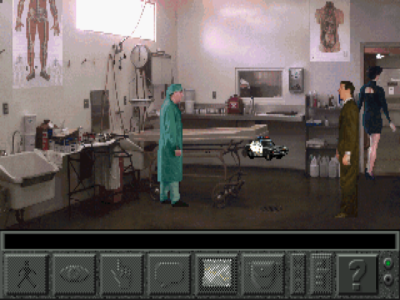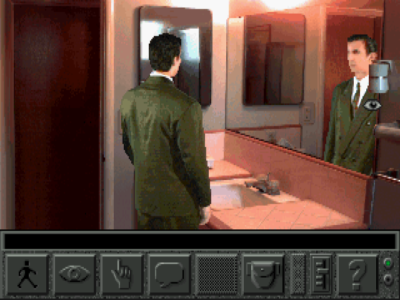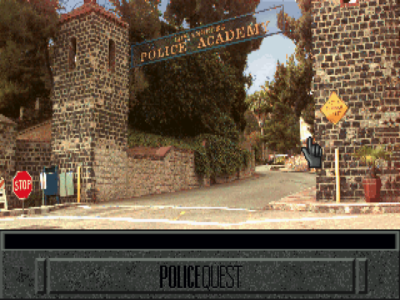
Police Quest 4: Open Season
Written by: Stoo
Date posted: February 27, 2009
- Genre: Adventure
- Developed by: Sierra
- Published by: Sierra
- Year released: 1993
- Our score: 6
Standing back a minute and thinking about it, Police Quest is a slightly ridiculous title for a game. It evokes images of a constable carrying a broadsword and venturing into a castle alongside some doughty dwarves, looking for treasure and a captured princess. Still I suppose Sierra called almost everything Quest, back when they were the ones inventing the graphical adventure genre in first place.
The PQ series was originally created by veteran cop Jim Walls, and followed the career of officer Sonny Bonds in a fictional small town. The emphasis was on a realistic depiction of police work. So you had situations like chasing speeding motorists and dealing with rowdy bikers, leading to work in homicide investigations and narcotics as Sonny’s career progressed. Throughout you were expected to follow proper procedure – reading crooks their rights, booking them in under the right code, carefully hunting for evidence at murder scenes, doing research back at base and so on. And not just kicking down a drug dealer’s door and shooting him in the head.
They weren’t always the most gripping of games; in fact they could get a bit bland and dorky with lengthy segments of having a shower then attending a daily briefing. Still, between us here we picked up a bit of a soft spot for the series. So, with me having covered the original (or VGA remake at least) a few years ago, we decided it was time to look at the rest. Rik set off with the next couple, covering the adventures of a promoted Sonny.
Now it’s my turn again, looking at Open Season. Walls was no longer writing, and with him he took Sonny, Lytton and pics of himself in a tight uniform. So now we have a new character in the form of Detective Carey, working in the sprawling metropolis of Los Angeles. Prominently credited on the project is Darryl F Gates, who was in fact chief of the real-life LAPD from 1978-1992. I’m not sure what his specific role was – the blurb just says “created by”. So I’d guess he didn’t write the specifics of the story the same way Walls did the first ones, but we would assume he had a signficicant involvement.
Although that said Gates is a bit of a controversial figure – this is the guy who’s career ended with the Rodney King riots. Looks like there were some questions over heavy handed treatment of gang members and… he once said casual drug use is treason. However this isn’t a political site and I’m not claiming to be well-informed on his history.
So let’s move on and do the obligatory “graphics bit”. It’s powered by Sierra’s SCI parser, which had been standard procedure for several years already. The hand-drawn art of before, however has been replaced with digitised photographs for all the locations. What’s more, apparently that’s the real Parker center in LA that you’re based in. Character sprites meanwhile are also based on recorded images of actors. They do suffer a bit from the low resolution and 256 colour palette – Carey’s shoes end up the same pleasant shade of brown as his suit.
It’s definitely not a style that’s aged as well as the cartoony look that was becoming popular at the time. But then we wouldn’t really expect cartoony for a story of this nature. There’s another improvement too, namely dropping the old habit of drawing some locations in a little window. If the game wants a tighter focus, it keeps to a full-screen view and instead uses larger sprites, which I believe was a new feature for SCI. Certainly a few closeups can’t hurt in bringing the characters to life.
Anyway the game kicks off to a pretty grim start, with a murder scene in South Central. Well, those are what Carey is supposed to look at for a living. Except it’s the murder of an old friend of his, a fellow cop. To make matters worse, you pretty quickly find the body of a dead child in a nearby dumpster. So we can quickly establish that this is going to be a dark and graphic business. I once likened the first Police Quest to an undemanding early 90s cop show; Rik felt at times he was watching an educational safety video. This however is more post-watershed material. There’s not actually much in the way of blood and guts onscreen. However the murderer you’re chasing is a pretty sick individual and as he racks up some more kills, you’re told in pretty great detail about how he mutilated the victims. Oh and along the way you’ll visit a neo-nazi and a strip club.
Anyway that first scene requires you to be quite thorough. You have to draw little chalk lines, get the SID officer to take pics, talk to the officers who first responded, and also question the shifty guys hanging around. You also take lots of notes, basically by clicking notebook on anyone and everything in sight. From here the rest of the game aims to continue as a realistic, by the book, investigation. That means trailing around the city talking to people, taking notes and picking up (potentially hidden) items. Also reporting back to base a lot to hand in potential clues to the experts and learn if any new information has arisen. Also to fill forms, hand them into your eternally deskbound partner, and occasionally use the firing range.
The events of the game take place over several days. Once you’ve discovered everything you’re supposed to, some sort of plot-advancing event occurs that’s usually a bit more dramatic than all the walking around. It might involve arresting a suspect, or a run in with reporters. The next day you should go see what forensic tests and autopsies have uncovered, and you’re invariably told of another murder as well. Then it’s back out into LA hopefully with something new to investigate.
The procedural stuff in of itself isn’t as onerous as the series’ reputation sometimes suggests. Usually, it’s just a case of being observant and thorough. Click talk, look and notebook on everything in sight. Occasionally look stuff up on department PC. The admin details are a bit of a chore, but ultimately just a few clicks work.
Also you can’t usually do anything wrong enough to be told “GAME OVER”, outside of “danger” situations (see below) or obviously inappropriate actions (the morgue assistant is annoying but resist the urge to pull your gun on her). Perhaps even more importantly you can’t (as far as I can tell) put yourself in the kind of unwinnable situation that leaves you to blunder on in a futile manner for another hour. I tended to be paranoid of both situations in older Sierra games, so the more forgiving approach is welcome.
What can be annoying is that sometimes a new item or event appears in a location you’ve already visited, but without any kind of announcement. Without even knowing you should be looking for it, you can only hit it by luck or a systematic search once you’ve run out of things to do. One example is receiving a phone call at your desk; I could only stumble across it when I returned to the office for a lack of better ideas. Another is an essential item, that turned up in a location that had last yielded something useful much earlier in the game and since then been irrelevant. And thus again I only really found it out of a blind search. Again though, at least you can’t let you miss that something and get stuck later on; the narrative is firmly paused until you stumble across it.
Apart from constant searches and questioning, there are some more immediate-action kind of moments – a couple of which constitute the few “use the otter on the pineapple” type actions we used to associate with adventures. Other times though it’s just a case of having the quick wits to click gun (draw weapon), talk (hands in the air!), cuffs etc. Too slow in that situation and you’ll end up stabbed. Oh and there’s an actual shootout at one point, to justify those trips to the range. Any “dangerous” situation is always pretty clearly signposted though.
Anyway, over the course of events a reasonably competent thriller of a story arises. You do feel like you’re getting an idea of what the killer is up to, along with the frustration of not knowing enough and the building pressure as more mutilated corpses are found. Eventually the clues build up towards pointing at a likely suspect, and there’s a sense of satisfaction in feeling you’re finally getting somewhere. There are a few oddities though; at one point you get a weird dream sequence, and events seem to heavily imply Carey has been drugged beforehand. Yet afterwards he just walks off without even challenging the person responsible or mentioning the event again.
Carey himself is a weakness though. Sonny Bonds maybe didn’t have a great amount of depth, but he was still likeable enough in his reliable side-parting manner. This guy though lacks either charm or personality. At one point his lieutenat chews out a colleague for visiting a bar in uniform, and instead of showing any sympathy Carey just flatly declares he admires the boss for being by-the-book. Yeah, I’m sure he’s great fun to go for a drink with.
There are one or two points where he does become more animated, snapping at colleagues. Which is great and makes sense. News reports are making people scared, the lieutenant is demanding results, and you’ve been hauled before city authorities to debrief them on progress, or lack of. Of course he’d be stressed. It’s just that the sudden bursts of emotion seem so at odds with his usual dialogue. Given that he’s supposed to be a developed character, and not a blank avatar for the player (as in say Quest for Glory), I really wanted to get more inside his head.
The game’s moral tone might raise a few eyebrows also (oh dear, serious social topics on a retro-gaming site. This isn’t even a GTA review.) Most of the black characters you meet are pretty negative; drunks and gangstas hanging around South Central, and a rapper out for publicity. Meanwhile the narration speaks in stern tones about a convenience store exploiting the poor with booze and unhealthy food, and it’s staffed by a “me no speak good engrish” asian woman. Oh and there’s an outrageously camp gay guy. I mean, obviously many people in real life match up to such stereotypes. But on some level it bugs me that all the examples here are pretty negative, and meanwhile the cops are mostly rather white.
Oh, but before I wrap up, here’s another positive: no sodding driving. Seriously if you have any familiarity with earlier games you’re probably cheering now. Maybe those predecessors had a reason to attempt driving sequences, what with Sonny being (at some points in his career) a uniformed cop on the beat. However the implementation usually had us spewing vile curses at Sierra. Here though, you just click a spot on the map and you’re there.
So then another Police Quest, another moderately enthusiastic score. Open Season doesn’t get enough right to be classified as a really essential adventure. Still if you want a gritty and authentic feeling experience, this one will serve you well. It’s not the compelling drama it could have been, after three games of Sonny’s small town adventure it’s still a change in tone whilst still feeling like a Police Quest. So for adventure fans, it should be involving enough to keep you occupied for a weekend.





 Posts
Posts